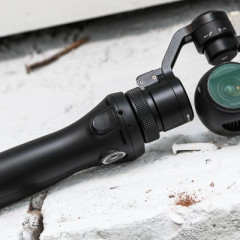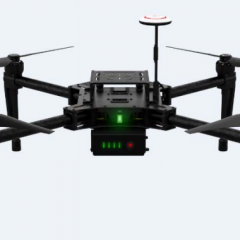DJI Osmo the handheld 4K Camera with 3 Axis gimbal is here
The DJI Osmo, which is a standalone 4K camera with a 3-axis gimbal in a neat handheld package has arrived. One of the prototypes of this device was shown off at CES in January in Vegas. It has since been tweaked and changed quite a bit. To see the Osmo Unboxing and Sample Footage shot with the Osmo see the end of the article. What can this bad-boy do? First there are two parts to the Osmo. The camera and the handle. Let’s take a look at the camera first. The Osmo camera uses the Sony Exmor R CMOS 1/2.3” sensor we know and love from the Inspire 1’s camera. It will feature a non-fisheye warped lens similar to the Inspire 1’s X3. The Osmo X3 camera has been mechanically changed to be better suited for handheld use. I’m guessing that means a few measure to increase robustness and durability as the camera on the Osmo will get bumped harder and more frequently than on an aerial platform. The gimbal has also been modified. It enables the option to be locked and flattened. The orientation of the tilt motor was changed as well as other smaller changes. The settings for the gimbal and camera can be changed in the DJI GO App. Phantom 3 and Inspire 1 pilots know this app from flying their drones. In the app, you will be able to change the gimbal settings/profiles, follow modes and control stick settings. If you already own an Inspire 1 you will be able to use your Inspire 1’s X3 camera and gimbal with the Osmo. The X3 camera from the Osmo is also compatible with the Inspire 1. Pricing and availability of the Handle only are TBA. The Inspire 1 camera will need a firmware update through the DJI GO App and then it will be ready for use. The smartphone doesn’t have to be mounted in the mobile mount on the handle. It can be operated from anywhere up to 25m (82 ft) from the device. A fully charged battery will get you 60 minutes of footage or 6 hours of standby time. The included battery charger will charge the battery in another 60 minutes. The device is not waterproof. You get an ISO range of 100-3200 for video and 100-1600 for photos. Shutter Speed settings range from 8s – 1/8000s. You can also capture exposures up to 30seconds while the camera is in M (Manuel) mode. The image size will be 4000×3000 pixels. The normal photo modes are available such as: Single Shot Burst mode (3/5/7 shots) AEB (Auto Exposure Bracketing) 3/5 bracketed frames Interval Timelapse Auto Panorama (where...
DJI Matrice 100 and X3 camera leaked (not Matrix 100 and X5 camera)
Update: DJI officially launched the Matrice 100 (not Matrix 100 as reported in earlier leaks). Also the camera is the X3 not X5 as previously thought. The X3 camera is the same camera as used in the Inspire 1. Breaking news: DJI is rumored to be releasing a new quadcopter called the Matrix 100. It will be similar to a phantom but will allow for a wider range of attachments and sensors. More for tinkerers. For Order Information please check >HERE<. In an email to dealers the following was stated: Features: Expansion Bays Additional expansion bays allow you to add components, customize the payload, and fly with any devices you want. Put cameras, sensors, computing boards, communication tools, and more into the sky, and gather data while completing complex jobs from a birds‐eye view. Universal Power and Communication Ports Plug in and fly with almost any device, and transmit data via the Matrix 100’s dual CAN and UART ports. There are two of each port on your platform, enabling you to mount and build a system that matches your needs. Dual Battery Compartments Add an additional battery compartment to achieve up to 40 minutes* of flight time. This gives greater power to both your platform and any additional devices or accessories that you wish to fly with. *Flight times vary based on payload and flight conditions, and the maximum 40 minute flight time tested when hovering with dual TB48D batteries and no additional payload. Customizable Mounting and Balancing Achieve perfect balance and an ideal flight experience by sliding the battery and other compartments around the body of your Matrix 100. Put your components exactly where you want them, and get the most out of your system. Adjustable Arm Angle for Greater Torque Flexible to match your flight needs, adjusting the arm angle of each of the 4 arms is quick and easy. Achieve increased yaw torque and greater response by tilting the arms to a 3 degree angle. 50% Less Vibrations, Rigid, Strong System To reduce vibrations, increase stiffness, and bring unmatched reliability, your Matrix 100 is made of strong, lightweight carbon fiber. Each of the arms contains DJI’s new soft vibration absorbing material that virtually eliminates feedback from the powerful motors, keeping your critical components stable and allowing unprecedented accuracy. Responsive, Quick Release Landing Pads Innovative landing pads or “feet” are installed at the base of each arm to protect your Matrix 100 when landing. These pads greatly reduce impact, protecting your system and eliminating the chance of your platform unintentionally lifting off of the ground. Also easy and quick to remove for replacement or upgrades. Dedicated...





